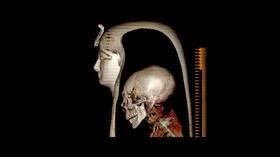Ancient Egyptian Pharaoh digitally unwrapped – study

Researchers have “digitally unwrapped” the mummified body of an ancient Egyptian pharaoh using 3D computerized tomography (CT) scans, allowing the carefully preserved remains to be viewed for the first time in three millennia.
The findings, published on Tuesday in the Frontiers in Medicine journal, provide fascinating insights into the appearance, life, and death of Pharaoh Amenhotep I, who lived about 3,500 years ago. His mummy was unearthed at a site called Deir el-Bahari, near the city of Luxor, around 140 years ago.
However, archaeologists had yet to uncover its secrets, since examining the remains would have been an invasive process that could have damaged the mummy’s intricate burial mask and delicate linen wrappings. The CT scans showed that Amenhotep I was about 35 years old when he died and is thought to have ruled the country from 1525 to 1504 BC.
“He was approximately 169cm (5ft 6in) tall, circumcised, and had good teeth. Within his wrappings, he wore 30 amulets and a unique golden girdle with gold beads,” said the study’s lead author, Sahar Saleem, a professor of radiology at Cairo University.
Likening the project to “unwrapping a gift,” Saleem added that Amenhotep I may have “physically resembled his father: he had a narrow chin, a small narrow nose, curly hair, and mildly protruding upper teeth.”
The researchers also found the brain intact, which distinguishes the remains from those of other high-profile pharaohs like Tutankhamun and Ramses II.
Although the scans showed multiple post-death injuries – likely caused by grave robbers – the team did not find any “wounds or disfigurement due to disease” that suggested a cause of death.
But the study did shed more light on the mummification and burial process. Amenhotep I, the second ruler of the 18th Dynasty, was the first pharaoh to be preserved with his forearms folded across his chest. Saleem said the jewelry and amulets shown in the scans also debunked theories that burial priests removed them for use by later pharaohs.
Describing the mummification process as “amazing,” Saleem noted that the remains were “lovingly repaired” and reburied by burial priests of the 21st Dynasty to keep them safe. The original tomb has not been found. The mummy is currently housed in Cairo’s Egyptian Museum.












